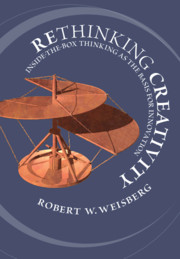Book contents
- Rethinking Creativity
- Rethinking Creativity
- Copyright page
- Dedication
- Contents
- Figures
- Tables
- Part I Introduction
- 1 Setting the Stage
- 2 Creativity
- Part II Analytic Thinking in Creativity
- Part III The Question of Extraordinary Thought Processes in Creativity
- Part IV The Psychometrics of Creativity
- Part V The Neuroscience of Creativity
- References
- Index
2 - Creativity
What It Is
from Part I - Introduction
Published online by Cambridge University Press: 01 October 2020
- Rethinking Creativity
- Rethinking Creativity
- Copyright page
- Dedication
- Contents
- Figures
- Tables
- Part I Introduction
- 1 Setting the Stage
- 2 Creativity
- Part II Analytic Thinking in Creativity
- Part III The Question of Extraordinary Thought Processes in Creativity
- Part IV The Psychometrics of Creativity
- Part V The Neuroscience of Creativity
- References
- Index
Summary
This chapter presents background information to support the examination of creativity. There has been disagreement among researchers concerning the most useful definitions for creative and related topics, so the chapter examines the various definitions that have been proposed by researchers, beginning with Guilford’s pioneering work starting in the 1950s. The chapter then proposes a definition for use in this book: a creative advance is novel and goal-directed; that is, creativity is novelty that has been produced intentionally. The chapter then traces the historical development of the genius view of creativity, which is the general idea that creative thinking is basically different from noncreative thinking and that creative people are different in significant ways from the noncreative. The chapter examines how the concept of genius has changed over the generations, and how current psychological views concerning creativity – using Mednick’s (1962) seminal theory as an example – show the influences of ideas that have, in various forms, existed for centuries. Chapter 2 provides the background for the discussion of creativity in the rest of the book.
Keywords
- Type
- Chapter
- Information
- Rethinking CreativityInside-the-Box Thinking as the Basis for Innovation, pp. 41 - 72Publisher: Cambridge University PressPrint publication year: 2020
- 1
- Cited by



